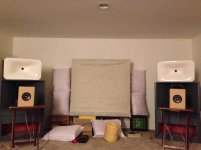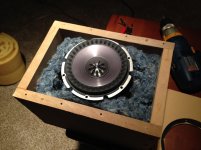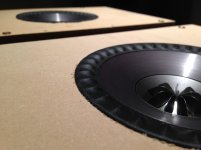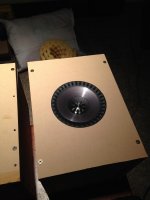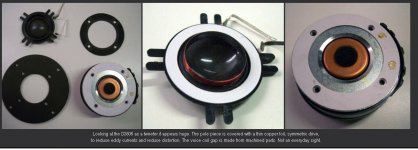After Zaph came out with his measurements of the Q100 drivers, I thought I'd get a pair of 'em. It was a good thing I did because KEF stopped selling the drivers to DIYers. Now you need a Q100 bookshelf serial number to get replacement drivers.
My goal was to do a sealed design that can be crossed to woofers or subs around 100-200 Hz. These are fairly small drivers, so they're not going to do 100 Hz with any conviction. Anyway, here is the design:
External dimensions: 8" W x 8.5" D x 11" H. 3/4" MDF.
After making the driver cutout there isn't much material left to hold the driver with screws. So, I went for a brace from the back to push the driver into the front baffle. I put some rubber sealant tape thingy along the cutout and on the brace.
I haven't spent much time on the crossover. It is something like a 4th order LR4 around 2 kHz (using MiniDSP). There is good phase overlap through the crossover and it sounds like one driver.
The sound is fantastic. It sounds very similar to my big system -- A7+SEOS-24. Tonally, it is very similar. The most surprising aspect was the size of the soundstage -- it is huge. Images are quite large, realistic and comparable to the BIG system. It extends well behind and to the sides of the speakers.
Dynamics are also quite good, although, they are limited when it comes to percussion. Music that has heavy content below 200 Hz starts to cause strain. But if they can be crossed at 200 Hz to a woofer, they ought to sound even better. Anyway, they sound quite good and I can finally calmly work on improving the A7 cabs. Questions? Comments?
Pics show the setup, cabinet, flush mounting, nearfield woofer response (unsmoothed) and farfield summed response (3rd octave smoothing).
My goal was to do a sealed design that can be crossed to woofers or subs around 100-200 Hz. These are fairly small drivers, so they're not going to do 100 Hz with any conviction. Anyway, here is the design:
External dimensions: 8" W x 8.5" D x 11" H. 3/4" MDF.
After making the driver cutout there isn't much material left to hold the driver with screws. So, I went for a brace from the back to push the driver into the front baffle. I put some rubber sealant tape thingy along the cutout and on the brace.
I haven't spent much time on the crossover. It is something like a 4th order LR4 around 2 kHz (using MiniDSP). There is good phase overlap through the crossover and it sounds like one driver.
The sound is fantastic. It sounds very similar to my big system -- A7+SEOS-24. Tonally, it is very similar. The most surprising aspect was the size of the soundstage -- it is huge. Images are quite large, realistic and comparable to the BIG system. It extends well behind and to the sides of the speakers.
Dynamics are also quite good, although, they are limited when it comes to percussion. Music that has heavy content below 200 Hz starts to cause strain. But if they can be crossed at 200 Hz to a woofer, they ought to sound even better. Anyway, they sound quite good and I can finally calmly work on improving the A7 cabs. Questions? Comments?
Pics show the setup, cabinet, flush mounting, nearfield woofer response (unsmoothed) and farfield summed response (3rd octave smoothing).
Attachments
Last edited:
On-axis looks good! Have you measured off-axis?
One think that hit my eye is that bump in the woofer response above 2kHz - or is it dip below since you aim xo at 2kHz? Anyway with minidsp you must use PEQ to make the acoustic slopes to follow acoustic measured LR4 curve also past xo-point. Only below -30dB level becomes not-so-important. This kind of easyness of response shaping make dsps superior to passive xos (unless you are a genius with loads of components to throw on a board)
And I think that you should make it a 3-way! Adding a 12" woofer or a pair of 10"s will give you more solid bass and clarity/naturalness for male voice and many instruments' fundamentals that a sub up to 200Hz can't deliver! There is lots of basic things happening between 100 and 200! I mean that the Q100 has too little Sd to do that well distortion-wise.
One think that hit my eye is that bump in the woofer response above 2kHz - or is it dip below since you aim xo at 2kHz? Anyway with minidsp you must use PEQ to make the acoustic slopes to follow acoustic measured LR4 curve also past xo-point. Only below -30dB level becomes not-so-important. This kind of easyness of response shaping make dsps superior to passive xos (unless you are a genius with loads of components to throw on a board)
And I think that you should make it a 3-way! Adding a 12" woofer or a pair of 10"s will give you more solid bass and clarity/naturalness for male voice and many instruments' fundamentals that a sub up to 200Hz can't deliver! There is lots of basic things happening between 100 and 200! I mean that the Q100 has too little Sd to do that well distortion-wise.
Last edited:
Looking at the picture of your room, made me to think over about the bass - I suppose those black boxes behind Q100s are your subs? I was thinking of some conventional single sub.
Integration to those woofers should be easy but you must take time to find right level of delay for q100s. Something in the range of 1-2ms I guess.
Integration to those woofers should be easy but you must take time to find right level of delay for q100s. Something in the range of 1-2ms I guess.
Thanks for your comments, Juhazi. No, I have not measured off-axis. Actually, I need to take the speaker outside to make proper farfield measurements. It's been windy and cold outside, maybe next weekend.
The first curve is the woofer nearfield. The mic is placed a few mm from the center of the cone. In such a measurement, the intent is to get an idea of the box alignment and the HF should be ignored, so, ignore everything above 1 kHz. I'm not showing the spliced nearfield/farfield response. I have it, I can post later today.
Yes, 3-way would be good. I designed the box with the goal of mating to a woofer (or multiple woofers). I have some PE buyout 8" woofers that I'm thinking of using in a line array configuration. Right now, I'm running it with a sub.
The first curve is the woofer nearfield. The mic is placed a few mm from the center of the cone. In such a measurement, the intent is to get an idea of the box alignment and the HF should be ignored, so, ignore everything above 1 kHz. I'm not showing the spliced nearfield/farfield response. I have it, I can post later today.
Yes, 3-way would be good. I designed the box with the goal of mating to a woofer (or multiple woofers). I have some PE buyout 8" woofers that I'm thinking of using in a line array configuration. Right now, I'm running it with a sub.
I haven't spent much time on the crossover. It is something like a 4th order LR4 around 2 kHz (using MiniDSP). There is good phase overlap through the crossover and it sounds like one driver.
Hi ra7,
Nice!
I use the KEF SP1632 (KEF R300-R900) in my design and it sounds awesome. One thing though, I wouldn't use the tweeter much below 2.5kHz, because it starts to distort like crazy below that. Distortion is of no issue if the tweeter cross-over is around 2.8-3kHz.
For details on KEF measurements:
KEF SP1632 Measurements!
Concentric Three - M5
Blog Archive Concentric Three - M5 Construction Update 1!
Blog Archive Concentric Three – M5 Construction!
Blog Archive New KEF SP1632 driver unit!
Regards
/Göran
Looking at the picture of your room, made me to think over about the bass - I suppose those black boxes behind Q100s are your subs? I was thinking of some conventional single sub.
Integration to those woofers should be easy but you must take time to find right level of delay for q100s. Something in the range of 1-2ms I guess.
The black boxes behind are my main system, Altec A7 front loaded horn with SEOS-24 on top. The most surprising thing about the Q100s was that when I first turned them on, I couldn't tell which speakers were playing -- the big ones or the Q100s!!! They sound so huge and do it without strain (well, there's a limit). I had to get up and put my ear to the Q100s to make sure they were playing and not the horns despite disconnecting the horns myself
I had built the boxes for the Q100s last December, but never finished the front baffles. The Altec A7s needed some surgery and improvement, so I needed an alternate system to play music while doing work on the A7s. I was not expecting these to sound so good, but now I can calmly work on the A7s
The Q100s integrate well with subs. You aren't going to time any frequencies below 100 Hz. The wavelengths are so long that delays will rarely make any difference. It is, however, important to make sure the phase overlaps near the crossover. You can use delays and slopes to adjust the phase overlap.
Hi ra7,
Nice!
I use the KEF SP1632 (KEF R300-R900) in my design and it sounds awesome. One thing though, I wouldn't use the tweeter much below 2.5kHz, because it starts to distort like crazy below that. Distortion is of no issue if the tweeter cross-over is around 2.8-3kHz.
For details on KEF measurements:
KEF SP1632 Measurements!
Concentric Three - M5
Blog Archive Concentric Three - M5 Construction Update 1!
Blog Archive Concentric Three – M5 Construction!
Blog Archive New KEF SP1632 driver unit!
Regards
/Göran
Thanks Goran!
Yes, they run into trouble doing midbass. Not bad, but they really deserve help down below. Your choice of crossover and woofer is very good. I have something similar in mind. I'm also thinking of pushing them into the corner and assisting them with a line array of woofers (corner loaded line-array). I've always wanted to try line arrays and have some spare buyout 8" woofers lying around.
How would you rate the speaker you have designed compared to the others? These Q100s really surprised me with their sound. I was not expecting them to be so close to the big horn rig. Makes me wonder whether all the time I've spent with horns was worth the effort. Yes, the Q100s don't go very loud, but tonally and spatially, they are very similar to the horns.
I looked at the distortion of the tweeter before picking the crossover point. It was doing fine upto about 1.2 - 1.5 kHz. I think after doing the slopes and adjusting the phase overlap, I may have ended up with a -6db point slightly higher than 2 kHz. Still, it is a rudimentary, first-pass crossover. I plan to take them outside to do proper measurements and develop a proper crossover.
Last edited:
I'm jealous ;-) very encouraging first results. Id love some coaxials or dual concentrics, small ones. Remember those Tannoys in the 90s, in pentagonal boxes? Id love to find some of those drivers.
You can buy the Q100 bookshelf's (about $200 a pop) and then extract the drivers, or just improve the crossover.
the tweeter are different on Q and R unit ?
Yes, probably, but how much I don't know.
How would you rate the speaker you have designed compared to the others?
If I compare to the best of my others designs, what's most noticeable is the extra huge sound stage it presents and the very large listening sweet spot it has.
You can sit, stand up or move around between the speakers without changing the sound very much.
Regards
/Göran
Both the tweeters do look similar, but who knows what's under the hood. I can do an impedance sweep and we can compare with Goran's posted results.
I was surprised by the soundstage size as well. The woofer is very smooth, as you can see in the nearfield, unsmoothed measurement. I used to think there is a problem with metal cones as well, but I just don't hear it. If the frequency response is smooth and you tame the resonances, it probably doesn't matter what material the cone is made of.
I was surprised by the soundstage size as well. The woofer is very smooth, as you can see in the nearfield, unsmoothed measurement. I used to think there is a problem with metal cones as well, but I just don't hear it. If the frequency response is smooth and you tame the resonances, it probably doesn't matter what material the cone is made of.
the tweeter are different on Q and R unit ?
IIRC, there are shorting rings in the R tweeter but not the Q.
If anyone knows of a good way to get the trim rings off of my R800ds surround speakers - they're a tighter fit than the Q100 - I could do sweeps of both under the same conditions.
- Status
- This old topic is closed. If you want to reopen this topic, contact a moderator using the "Report Post" button.
- Home
- Loudspeakers
- Multi-Way
- DIY with KEF Q100 drivers
